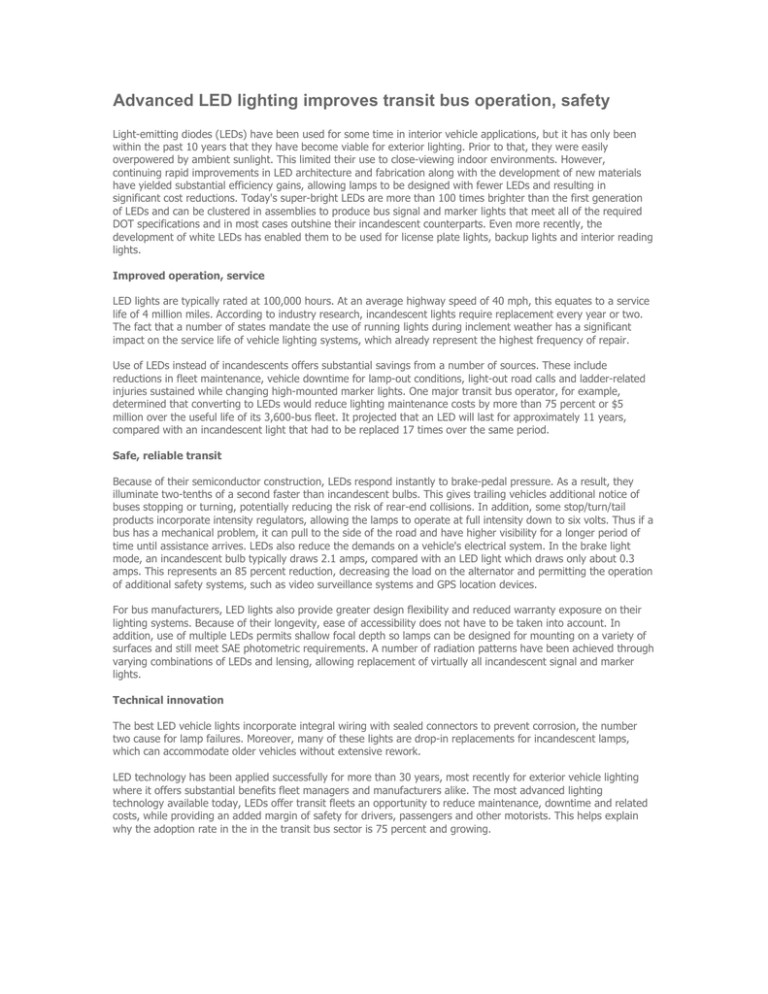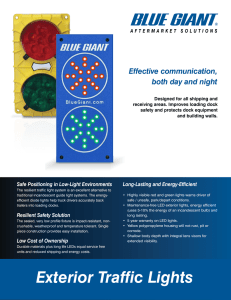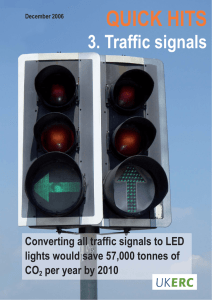Advanced LED lighting improves transit bus operation, safety
advertisement

Advanced LED lighting improves transit bus operation, safety Light-emitting diodes (LEDs) have been used for some time in interior vehicle applications, but it has only been within the past 10 years that they have become viable for exterior lighting. Prior to that, they were easily overpowered by ambient sunlight. This limited their use to close-viewing indoor environments. However, continuing rapid improvements in LED architecture and fabrication along with the development of new materials have yielded substantial efficiency gains, allowing lamps to be designed with fewer LEDs and resulting in significant cost reductions. Today's super-bright LEDs are more than 100 times brighter than the first generation of LEDs and can be clustered in assemblies to produce bus signal and marker lights that meet all of the required DOT specifications and in most cases outshine their incandescent counterparts. Even more recently, the development of white LEDs has enabled them to be used for license plate lights, backup lights and interior reading lights. Improved operation, service LED lights are typically rated at 100,000 hours. At an average highway speed of 40 mph, this equates to a service life of 4 million miles. According to industry research, incandescent lights require replacement every year or two. The fact that a number of states mandate the use of running lights during inclement weather has a significant impact on the service life of vehicle lighting systems, which already represent the highest frequency of repair. Use of LEDs instead of incandescents offers substantial savings from a number of sources. These include reductions in fleet maintenance, vehicle downtime for lamp-out conditions, light-out road calls and ladder-related injuries sustained while changing high-mounted marker lights. One major transit bus operator, for example, determined that converting to LEDs would reduce lighting maintenance costs by more than 75 percent or $5 million over the useful life of its 3,600-bus fleet. It projected that an LED will last for approximately 11 years, compared with an incandescent light that had to be replaced 17 times over the same period. Safe, reliable transit Because of their semiconductor construction, LEDs respond instantly to brake-pedal pressure. As a result, they illuminate two-tenths of a second faster than incandescent bulbs. This gives trailing vehicles additional notice of buses stopping or turning, potentially reducing the risk of rear-end collisions. In addition, some stop/turn/tail products incorporate intensity regulators, allowing the lamps to operate at full intensity down to six volts. Thus if a bus has a mechanical problem, it can pull to the side of the road and have higher visibility for a longer period of time until assistance arrives. LEDs also reduce the demands on a vehicle's electrical system. In the brake light mode, an incandescent bulb typically draws 2.1 amps, compared with an LED light which draws only about 0.3 amps. This represents an 85 percent reduction, decreasing the load on the alternator and permitting the operation of additional safety systems, such as video surveillance systems and GPS location devices. For bus manufacturers, LED lights also provide greater design flexibility and reduced warranty exposure on their lighting systems. Because of their longevity, ease of accessibility does not have to be taken into account. In addition, use of multiple LEDs permits shallow focal depth so lamps can be designed for mounting on a variety of surfaces and still meet SAE photometric requirements. A number of radiation patterns have been achieved through varying combinations of LEDs and lensing, allowing replacement of virtually all incandescent signal and marker lights. Technical innovation The best LED vehicle lights incorporate integral wiring with sealed connectors to prevent corrosion, the number two cause for lamp failures. Moreover, many of these lights are drop-in replacements for incandescent lamps, which can accommodate older vehicles without extensive rework. LED technology has been applied successfully for more than 30 years, most recently for exterior vehicle lighting where it offers substantial benefits fleet managers and manufacturers alike. The most advanced lighting technology available today, LEDs offer transit fleets an opportunity to reduce maintenance, downtime and related costs, while providing an added margin of safety for drivers, passengers and other motorists. This helps explain why the adoption rate in the in the transit bus sector is 75 percent and growing.



